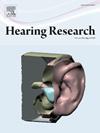Impaired brainstem auditory evoked potentials after in utero exposure to high dose paracetamol exposure
IF 2.5
2区 医学
Q1 AUDIOLOGY & SPEECH-LANGUAGE PATHOLOGY
引用次数: 0
Abstract
Paracetamol is an analgesic and antipyretic medication regarded as the safest over-the-counter pain and fever relief option during pregnancy. Paracetamol and its metabolites are known to reach the developing fetus through direct placental transfer and can cross the blood brain barrier. Several recent, large-scale epidemiologic studies suggest that in utero paracetamol exposure can increase the risk of neurodevelopmental conditions, including autism spectrum disorder (ASD), attention deficit hyperactivity disorder (ADHD) and developmental delay (DD). Since auditory processing deficits are a common feature of ASD, we hypothesized that animals exposed to paracetamol in utero will have impaired auditory brainstem function. We investigated this hypothesis by recording and analyzing click-evoked auditory brainstem responses (ABR) at postnatal day 21 and 29 in Sprague-Dawley rats. In utero exposure to high dose paracetamol exposure had no impact on body or brain weight. However, high dose paracetamol exposure did significantly delay ear opening and resulted in elevated ABR thresholds, and longer wave and interwave latencies. These changes in wave latency extended to the highest click intensity tested but were most severe near threshold. This data suggests that development and function of the auditory brainstem may be impacted by high dose paracetamol exposure and that simple, non-invasive tests of auditory function have utility as an early screening tool for neurodevelopmental disorders.
子宫内接触高剂量扑热息痛后脑干听觉诱发电位受损。
扑热息痛是一种镇痛和退烧药,被认为是孕期最安全的非处方止痛和退烧药。众所周知,扑热息痛及其代谢物可通过胎盘直接转移到达发育中的胎儿体内,并可穿过血脑屏障。最近的几项大规模流行病学研究表明,子宫内接触扑热息痛会增加患神经发育疾病的风险,包括自闭症谱系障碍(ASD)、注意缺陷多动障碍(ADHD)和发育迟缓(DD)。由于听觉处理缺陷是自闭症谱系障碍的常见特征,我们假设在子宫内暴露于扑热息痛的动物会出现听觉脑干功能受损。我们通过记录和分析 Sprague-Dawley 大鼠出生后第 21 天和第 29 天的点击诱发听性脑干反应(ABR)来研究这一假设。子宫内暴露于高剂量扑热息痛不会影响大鼠的体重或脑重。然而,接触高剂量扑热息痛确实会明显延迟耳朵张开的时间,并导致 ABR 阈值升高、波潜伏期和波间潜伏期延长。波潜伏期的这些变化延伸到测试的最高点击强度,但在阈值附近最为严重。这些数据表明,听觉脑干的发育和功能可能会受到接触高剂量扑热息痛的影响,而简单、无创的听觉功能测试可作为神经发育障碍的早期筛查工具。
本文章由计算机程序翻译,如有差异,请以英文原文为准。
求助全文
约1分钟内获得全文
求助全文
来源期刊

Hearing Research
医学-耳鼻喉科学
CiteScore
5.30
自引率
14.30%
发文量
163
审稿时长
75 days
期刊介绍:
The aim of the journal is to provide a forum for papers concerned with basic peripheral and central auditory mechanisms. Emphasis is on experimental and clinical studies, but theoretical and methodological papers will also be considered. The journal publishes original research papers, review and mini- review articles, rapid communications, method/protocol and perspective articles.
Papers submitted should deal with auditory anatomy, physiology, psychophysics, imaging, modeling and behavioural studies in animals and humans, as well as hearing aids and cochlear implants. Papers dealing with the vestibular system are also considered for publication. Papers on comparative aspects of hearing and on effects of drugs and environmental contaminants on hearing function will also be considered. Clinical papers will be accepted when they contribute to the understanding of normal and pathological hearing functions.
 求助内容:
求助内容: 应助结果提醒方式:
应助结果提醒方式:


